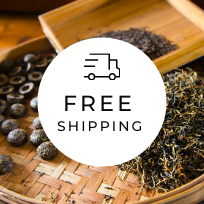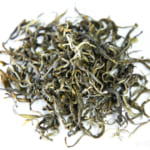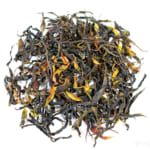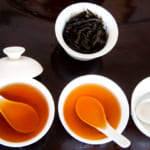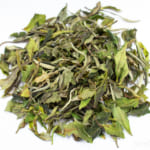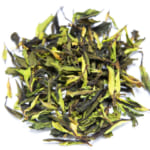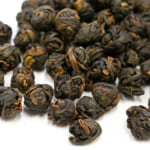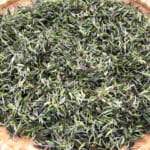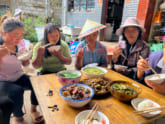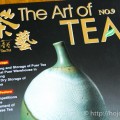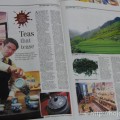- HOME >
- Types of Tea
2025 Da Xue Shan Wild White Tea Now Available from Yunnan
- [2025.07.31] Posted By Akira Hojo
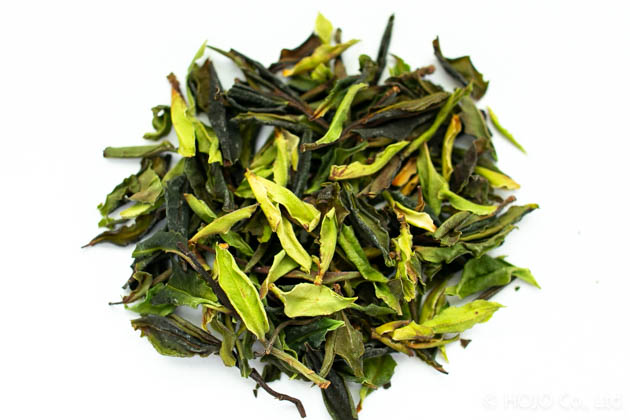
The 2025 harvest of Da Xue Shan Wild White Tea is now available.
Crafted from truly wild Camellia taliensis trees growing naturally in the high-altitude forests of Yunnan, this tea offers a purity and character unique to its origin.
This year’s unusually dry climate during the withering season was ideal, resulting in a floral and clean tea. We look forward to sharing how this year’s tea has turned out.
Truly Wild Tea from a Rare Species
Da Xue Shan Wild White Tea stands out for two main reasons.
First, it’s made from truly wild tea trees that grow naturally in the mountains, completely untouched by human cultivation.
Second, it comes from a rare tea species called Camellia taliensis, which is different from Camellia sinensis used in most teas.
By “wild,” we don’t mean old tea trees or abandoned tea garden. These are trees that have grown freely in the mountain forests for generations, just like wild plants.
What makes wild tea special can be felt most clearly in the finish. After drinking, the aftertaste is incredibly deep and long-lasting, lingering in the throat with a rich and heavy presence.
Camellia taliensis: Tradition and Distinctive Flavour
Camellia taliensis is a close relative of Camellia sinensis, which is commonly used to produce traditional teas across China. However, in certain mountainous villages of Yunnan, ethnic minority communities have long used Camellia taliensis instead, harvesting the leaves from wild trees, pan-frying them at home, and drinking the tea as part of their daily life. This long-standing local tradition highlights a distinct cultural lineage separate from mainstream tea production.
This wild white tea has a distinctive flavour profile that sets it apart. It carries a unique fruity note, often reminiscent of Shine Muscat grapes and fresh young tomatoes. Smooth, refreshing, and layered with depth, it’s no surprise that this tea remains one of the most popular in our collection.
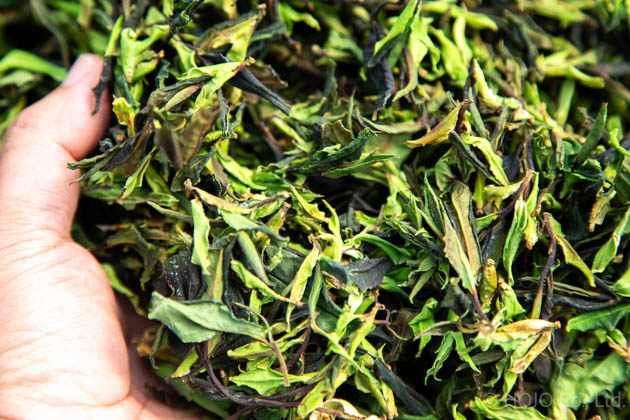
The Challenges of Processing Camellia taliensis into White Tea
Camellia taliensis is characterized by its much thicker stems, which make it especially challenging to process into high-quality white tea.
Technically, you can make white tea by simply withering and drying the leaves. But if the process isn’t handled properly, moisture often remains trapped in the thick stems. This can lead to over-fermentation(enzymatic oxidation), resulting in browning and a musty, off smell. In fact, many wild white teas in the market with a dark, leathery appearance similar to wood ear mushrooms are usually the result of poor processing.
To avoid this, we travelled to Yunnan before the harvest season began and oversaw every step of the production ourselves. This included selecting the raw leaves, spreading the leaves properly, ensuring good air circulation, and checking the final moisture content. Our goal was to produce a tea that looks fresh and vibrant, like it was just plucked from the mountain, with a clean green appearance and a pure, uplifting aroma.
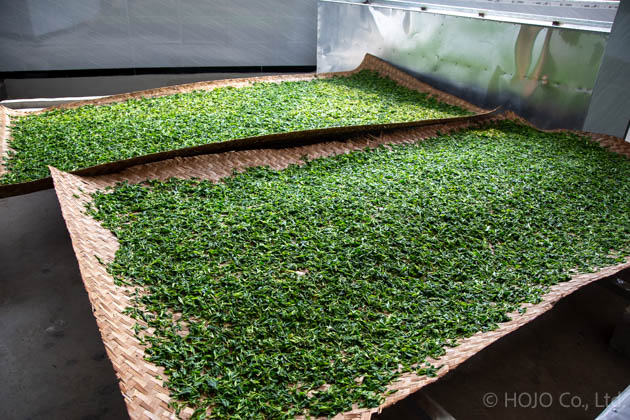
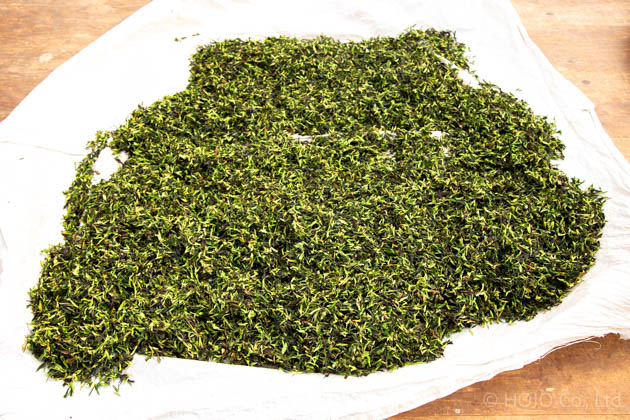
Floral and Shine Muscat-like Flavor
Because rainfall and humidity vary each year, the flavor profile of white tea can change noticeably, even when using the exact same processing method.
This year, from late March to mid-April, which is the peak white tea season, the weather in Yunnan was unusually dry. It hardly rained at all, and the air was so dry that even without spin drying, my laundry dried completely within two to three hours at the place I stayed.
Thanks to these ideal conditions, the withering process went exceptionally well. As a result, this year’s Da Xue Shan Wild White Tea has a clean taste with soft floral notes and a hint of Shine Muscat grapes.
Flavor Development Over Time
At this early stage, the flavor is still quite mild, as it is freshly produced. However, when stored in an oxygen-free environment, its character changes gradually. From our past experience, the sweet notes become more noticeable after a few months. After about three years, a fruity note similar to grapes starts to appear. With longer aging, this flavor continues to develop and becomes more like raisins.
One of the unique pleasures of white tea is being able to enjoy it at different stages. You can appreciate the refreshing floral sweetness when new, and also enjoy the richer character that appears over time. We hope you will experience both the freshly made and the aged versions to see how this wild mountain tea evolves.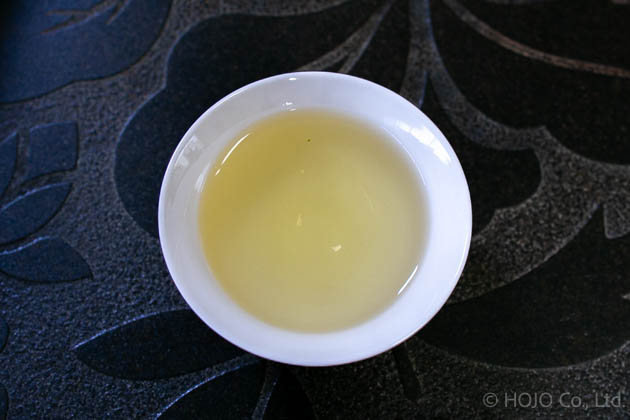
Incredible Impact: Da Xue Shan Wild White Tea Sparkling
Da Xue Shan Wild White Tea tastes amazing whether brewed hot or enjoyed as a cold infusion. Because white tea is processed with minimal heat, its natural enzymes are still active.
When you brew it with hot water, these enzymes are activated during infusion, triggering a light fermentation that brings out a subtle fruity aroma—almost like a lightly fermented black tea. On the other hand, cold infusion keeps the enzymes inactive, allowing the tea’s floral notes and Shine Muscat-like sweetness to come through more clearly.
If you take it a step further by carbonating the cold-brewed tea using a device like Drinkmate, it turns into a surprisingly refreshing drink. Commercial sparkling water often has a flat or odd taste, and blending it with cold-brewed tea does not deliver the same result. Freshly carbonated white tea is vibrant, aromatic, and naturally sweet.
We highly recommend trying it out with a carbonation machine to create your own sparkling white tea and experience the difference.
Related Articles
How to get the latest update on HOJO Tea?
1. Follow Twitter, 2. Click "Like" on Facebook, and 3. Subscribe in newsletter. You can have the latest tea news from HOJO Tea.
 Subscribe the Newsletter to enjoy the privileges
Subscribe the Newsletter to enjoy the privileges- You may receive a free sample upon purchase, or you may have the priority to purchase special products. So please remember to subscribe our newsletter as well as the social network.
- Yunnan Chun Jian Green Tea from High Mountain Gardens
- Yunnan Chun Jian Green Tea is now available.This tea is made from naturally grown leaves harvested from high mountain gardens at 2100m above sea level. It has a rich, long-lasting lingering aftertaste, comparable to raw Pu-erh tea. Yunnan as a Distinctive Tea Growing Region Over the past 20 years, we have explored a wide range …
- Limited Loose Leaf Release of 2025 Da Xue Shan Wild Raw Pu-erh Tea
- We have released the 2025 loose-leaf version of Da Xue Shan Wild Raw Pu-erh Tea.This tea comes from wild tea trees that grow naturally in the high mountains of Yunnan Province, at elevations above 2000 meters. This year, we were only able to secure a small quantity for retail, and the current release is available …
NEW ARTICLES
 Yunnan Chun Jian Green Tea from High Mountain Gardens
Yunnan Chun Jian Green Tea from High Mountain Gardens- Yunnan Chun Jian Green Tea is now available.This tea is made from naturally grown leaves harvested from high mountain gardens at 2100m above sea level. It has a rich, long-lasting lingering aftertaste, comparable to raw Pu-erh tea. Yunnan as a Distinctive Tea Growing Region Over the past 20 years, we have explored a wide range …
 Limited Loose Leaf Release of 2025 Da Xue Shan Wild Raw Pu-erh Tea
Limited Loose Leaf Release of 2025 Da Xue Shan Wild Raw Pu-erh Tea- We have released the 2025 loose-leaf version of Da Xue Shan Wild Raw Pu-erh Tea.This tea comes from wild tea trees that grow naturally in the high mountains of Yunnan Province, at elevations above 2000 meters. This year, we were only able to secure a small quantity for retail, and the current release is available …
 2025 Da Xue Shan Wild White Tea Now Available from Yunnan
2025 Da Xue Shan Wild White Tea Now Available from Yunnan- The 2025 harvest of Da Xue Shan Wild White Tea is now available. Crafted from truly wild Camellia taliensis trees growing naturally in the high-altitude forests of Yunnan, this tea offers a purity and character unique to its origin. This year’s unusually dry climate during the withering season was ideal, resulting in a floral and …
 Why Do Some Teas Taste Astringent? Exploring the Causes and Mechanisms of Astringency
Why Do Some Teas Taste Astringent? Exploring the Causes and Mechanisms of Astringency- Tea can range from having no noticeable astringency to possessing a very strong one. What causes this astringency? This article explores the causes and mechanisms behind astringency in tea. Causes of Astringency Astringency arises from the binding of tea components to proteins in the oral cavity, creating a sensation of tightness or dryness. The tongue …
 The Impact of Heat Sources on Tea Flavor
The Impact of Heat Sources on Tea Flavor- It is widely recognized that the material of a kettle plays an important role in shaping the taste of water for brewing tea. Yet, an often overlooked but equally significant factor is the type of heat source used to boil the water. Different heat sources, whether gas, electric, charcoal, or wood fire, can impart distinct …
 New Release of High Mountain White Tea
New Release of High Mountain White Tea- We are pleased to introduce our High Mountain White Tea, sourced from a unique tea garden with two key features: 1. Located at an altitude of 2200-2300m2. Completely wild and untended The ideal natural conditions of this garden result in tea of exceptional quality, offering a pure and gentle, nourishing taste. High Altitude and Wild …
 New Release of Da Xue Shan Wild White Tea 2024
New Release of Da Xue Shan Wild White Tea 2024- We have released the 2024 Da Xue Shan Wild White Tea Loose Leaf. This tea was produced under our direct supervision during our stay in Yunnan Province, ensuring meticulous production management on site. Definition of Wild Tea in Yunnan Province People in Yunnan strongly associate Camellia taliensis with wild tea, regardless of where it is …
 New Release of Wild Pu-erh Jasmine Pearl
New Release of Wild Pu-erh Jasmine Pearl- Out of curiosity, we decided to create a jasmine tea based on Da Xue Shan Wild Raw Tea. This resulted in an exceptionally rare tea, not only in Japan but also in China. Custom Production Network for Jasmine Tea At our store, we source various types of base teas from different regions during the spring. …
 2024 Overview: Our Yunnan White Tea Quality, Process, and Weather Insights
2024 Overview: Our Yunnan White Tea Quality, Process, and Weather Insights- One of the teas we’ve been focusing on in Yunnan Province is white tea. Historically white tea has been produced in both Fujian Province and Yunnan Province for a long time. While white tea from Fujian Province is well-managed during processing, we are dissatisfied with the quality of the raw materials due to the use …
 Yunnan’s Hospitality Culture: Expressed Through Meals
Yunnan’s Hospitality Culture: Expressed Through Meals- In China, as a form of greeting, it’s common to say “你吃饭了吗?” which means “Have you eaten?” However, in Yunnan Province, the phrase “吃饭” is often used in various situations, more like “Eat, eat,” serving as an invitation to share a meal. Yet, with prolonged exposure to Yunnan, one comes to understand that these meal …
Shop Info

Address:Lot No. T-215, 3rd Floor, The Gardens Mall, Mid Valley City, Lingkaran Syed Putra, 59200 Kuala Lumpur
Tel: +603-2287-4537
Business Hour: 10am to 10pm
Category
- New Arrival at HOJO Online Shop
- Featured Articles
- Newsletter
- Types of Tea
- Origin of Tea
- Teapot and Tea Equipment
- Tea Column
- How to enjoy tea
- Tea Processing
- How to choose quality tea
- Tea constituents and functional effect
- Safety of Tea
- Foods
- Tea Business Operation
- Hobby and Outdoor Activity
- Ranking of Tea
- Video
- FAQ
- Media Release
Profile

- AKIRA HOJO
- I invite you to experience my tea selections.I was born in Nagano, Japan. In university, I studied agricultural chemistry, and I have the master degree in food science. I worked in Japanese food industry for 10 years. I involved in R&D, QC and QA. As a factory manager, I implemented ISO9000 series and managed the factory.
- The Art of Tea Magazine
- We posted the article on “The Art of Tea Magazine No.9, the magazine is published in Taiwan. We featured some scientific view about the tetsubin
- New Straits Times
- The Malaysian National Newspaper, New Straits Times featured HOJO Tea on 17-Oct-2007.


